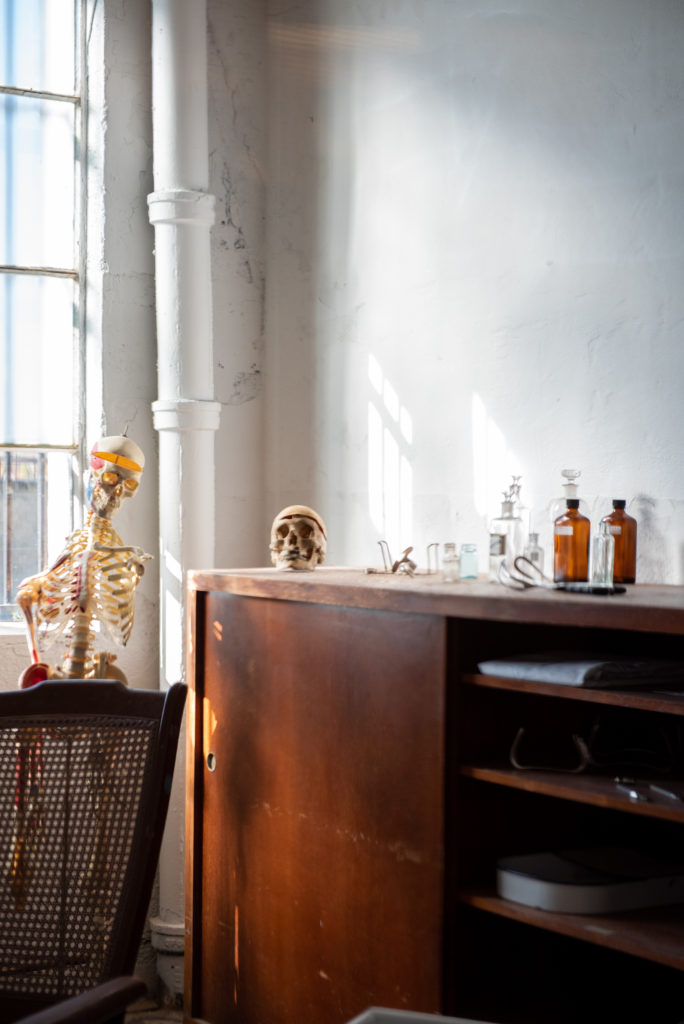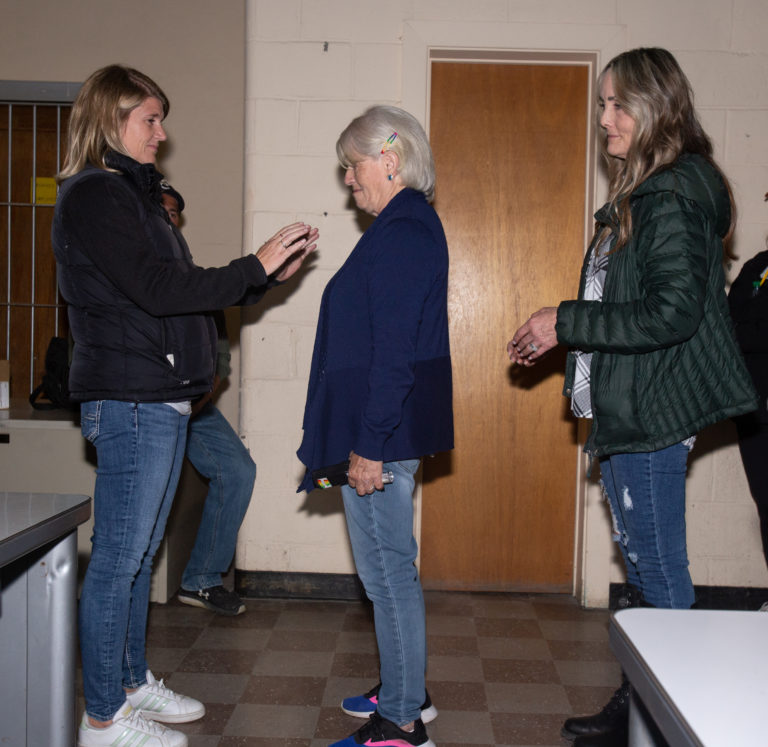More than Superstition
A haunted prison fosters connection during COVID-19

Story by Luke Seymour

Photos by Aston Kinsella

Photos by Collin Kuehn

Illustration by Mariah Karis



Out of the many feelings a person might experience when they lie in the well-maintained grass at the center of an abandoned courtyard of a supposedly haunted prison, one is a surprising sense of elation.
There’s an enormous calming sense at the heart of the Old Montana Prison. It is not an empty calm, but a calm heavy with time — an atmosphere that swells with memory.
The basketball court is bleach white, accessorized with skeletal hoops absent of netting. The vacant guard towers look like empty nests that once housed terrible birds of prey. In contrast, a square of pavement for hopscotch looks cared for, the numbers and shapes newly painted with vibrant pastel colors. An older couple walks slowly around the walls as they whisper to each other in a hush.
As 2021 comes to a close, a year defined by the anxiety that comes from COVID-19 politics — there’s something therapeutic about an escape into the past — to lie at the center of a prison of lost souls.
The Old Montana Prison was established in 1871 in an effort described in the tour handbook as “an attempt to tame the wild west.” In 1959, a vicious prison riot broke out and shook the state of Montana with reports of violence, chaos and murder.
The riot led to the destruction of one of the prison’s cell towers after a member of the National Guard fired a bazooka at the building to stun the prisoners. Three people were reported dead after the riot, including the Deputy Warden, Theodore Rothe. It is believed that the core reason for the riot was due to overcrowding, which was a problem that continued to be unaddressed until the prison’s closure in 1979.
Since then, the prison has been converted into a museum and is a well known northwestern Montana tourist destination, and one of the main sources of revenue for the City of Deer Lodge, Montana. The museum hosts birthdays, car raffles and even performances from touring bands. The Hell’s Belles, an all-female AC/DC cover band from Seattle, performed on the concrete block in the middle of the prison courtyard in 2018 to an enthusiastic crowd.
However, there is one attraction that has earned the Old Montana Prison a reputation for being one of the spookiest destinations in the West. For decades now, it has gained steady notoriety for being a haunted hotspot, and as a result it has attracted attention from ghost hunters all over the country. After being visited in 2012 by the hit SYFY Channel TV show “Haunted Collector,” the prison started holding annual ghost tours. For a handful of nights each year, guests are treated to a tour through some of the prison’s alleged haunted facilities. Over the years, guests have reported feeling touched on their neck and shoulders and experiencing nausea.
The prison proved its lasting power in early 2020 after a brief three-month period where it shut down to clean and sanitize the facility in compliance with government mandates. It was one of the few businesses in Deer Lodge and in all of Montana that remained open during the height of the COVID-19 pandemic.
“It seemed like people just wanted to get out,” said Lisa Garcia, a longtime prison events coordinator and paranormal investigator. “We had people showing up right off the bat and people calling us when we were closed asking us ‘are you open? Are you open?’ I think people just needed to get out because they were already so tired of being cooped up for so long.”
There’s a tempting observation to be made about the prison being as successful as it was during the middle of a pandemic: People rushing to embrace a timeworn prison to escape a prison of pandemic crisis. The image of guests pacing old, dilapidated hallways just because it beats endlessly pacing around their own living rooms, is both provocative and amusing.



“Obviously you’re going to get a lot of people who are in it just for the adrenaline rush, right?” said Jennifer Keintz, a 25-year high school journalism teacher and one of the Old Montana Prison’s newest paranormal investigators and historic tour guide. “But I think outside of the thrill of dealing with the paranormal and seeing for yourself whether it’s real or not, the whole experience is really about stories: Both the ones that we write for ourselves and the one that we get to write with and interact with others. That kind of interactive experience can be really therapeutic.”
On a cold and clear Saturday night in October, more than 20 strangers squeezed into a small wooden room to live the experience Keintz talks about. It was the very last tour of the season. After everyone was accounted for, Keintz addressed those gathered and announced that the room they were in was the administration offices. It was the room they usually saved for last because she considered it to be the most haunted part of the prison. The last time she’d brought a group here she said she heard a growl.
Keintz passed around electro-magnetic field detectors that could “sense spiritual activity” and would glow red and beep if there was a spirit nearby. She then asked for a volunteer to participate in what she called “The Human Pendulum.” The purpose of the activity was to have the volunteer who acted as the “medium” stand perfectly still between two other volunteers who would act as “spotters.” She would ask the spirits a series of yes or no questions.
If the ghosts answered “yes,” the spirits were instructed to push the volunteer forward. If they answered “no,” they would push them backward.
The first volunteer was a young college student named Jeremy Jacobs who was there with a friend. Keintz asked the spirits if they wanted the group to be there or to leave— there was no response. But, when she asked if the spirit was human or not, Jacobs lost his balance. Keintz rushed to thank the spirits and dismissed Jacobs.
“I’m a big history buff, so that’s mostly the reason I’m here,” Jacobs said as he shrugged his shoulders. “This was really the first night I ever felt like I was connecting to something beyond what was here,” he said as he knocked his hiking boots against the ground. “Like — here — here.”
The next volunteer, Deidra Beacom, was more shaken than Jacobs. She was holding her own hands to keep them from shaking. Keintz again asked if the spirit was pleased the group was there; Beacom let out a squeal and fell back. After she regained her composure, she remained shaking. Keintz said Beacom could opt out of the exercise, but Beacom insisted on continuing. After a few more questions that produced little effect, Keintz dismissed Beacom.




Previous
Next
“I’ve always believed in the supernatural and I think that’s why it scared me so much,” Beacom said. “It was also a very powerful and humbling experience, that’s for sure.”
Beyond the pendulum, the supernatural interaction was minimal. At one point, the group lined up against the jail cells and sang along to “Sweet Caroline” to “provoke the spirits into singing or whistling along,” Keintz said. Then the group moved on to the chapel to listen to a series of ‘80s radio hits in the dark while the tour guides set up sensory-activated music boxes to play whenever spirits were present. Other than a singular music box that played continuously, there was no apparent interaction. In the shower area of the prison, a group member claimed he felt cold water drip on his head when there was no source of water to be seen. Another said she felt the touch of fingers on the back of her neck.
While each of these moments were captivating, whether truly supernatural or not, the most moving moment of the tour came at the end. Keintz ended the tour in the gift shop. She thanked everyone for coming and invited them to continue to explore the property and bid all of them a good rest of the year. The crowd dispersed into the parking lot to talk amongst themselves. A young college student asked Beacom about her Pendulum experience while Jacobs talked with his friend about his spooky showdown. Two men, one from Deer Lodge and one from Kalispell, exchanged photos they believed caught a glimpse of a
spirit.
“People just want to feel connected with other people,” Keintz said. “Even if some of those people are, you know, not alive.”


